The pear is not only extremely decorative, but also bears delicious fruit. Here we show what you need to know about planting, caring for and harvesting.

rock pears (amelanchier) delight the gardener's heart all year round: in spring their lush white flowers shine in the garden, in summer the healthy fruits can be nibbled and in autumn the leaves shine in every imaginable red and orange tones. If you don't have a service pear in your garden yet, this article will provide you with all the information you need if you want to get a service pear soon. Here we tell you everything about the origin, the varieties, the planting, care and harvesting of the popular shrub.
contents
-
Rock pear: origin and properties
- Rock pear fruit: edible or poisonous?
-
Pear species and varieties
- Serviceberry (Amelanchier ovalis)
- Copper Pear (Amelanchier lamarckii)
- Alder-leaved pear (Amelanchier alnifolia)
- Rock pear (Amelanchier laevis)
- Amelanchier arborea
- Canadian pear
- Buy pear pear
-
plant service pear
- The right location for the service pear
- This is how you proceed when planting the service pear
- Plant service pear as a standard
-
Cultivate service pear
- Pour and fertilize the pear
- Cut rock pear
- multiply service pear
- Overwinter service pear
- Harvesting and storing Rock Pear fruit
Rock pear belonged to the rose family (Rosaceae). The botanical genus name amelanchier comes from the Franco-Breton term "amélanche" for the native of Brittany Amelanchier ovalis. The word "amélanche" is of Celtic origin and means something like "little apple". But the pear is not a pear Apple (penalty) and neither pear (Pyrus communis). The ripe fruits of the bush are more reminiscent of blueberries (Vaccinium) and also taste similar, plus a hint of marzipan. Rock pears used to be an important fruit plant. This can also be seen from the fact that the shrub is still called "currant tree" or "raisin tree" in northern Germany. The fruits were collected, dried and then used like raisins.
Rock pear: origin and properties
Most species of pear come from North America. At least one species is native to every US state (except Hawaii) and every Canadian province and territory. Only three species are an exception: two are native to Europe, only one to Asia.
Rock pears are deciduous shrubs. The shoots are thin and olive green. While all species initially grow upright, they widen more and more over the course of their lives and form expansive crowns. The leaves are three to seven centimeters long, alternate and elliptical. The leaf blades are often covered with delicate hairs. In some species, the leaves already show a reddish color when they sprout and then later change to a greenish color. In autumn the leaves turn bright orange to dark red.

All species produce a multitude of white, star-shaped flowers in spring, clustered in racemes.
In summer, the fruits ripen as berry-like pome fruit. They are red to purple, almost black, and can be 5 to 15 millimeters in diameter. Depending on the type and variety, the fruits taste bland and bitter or pleasantly sweet.
Rock pear fruit: edible or poisonous?
Apples or raspberries have certainly eaten most of them often. However, wild fruit such as sloe or elder is less common. And very few will have tasted the fruit of the pear, because the myth is still widespread that the pear is poisonous and must not be eaten.
It is true that the leaves and seeds of the fruit contain cyanogenic glycosides, which are very toxic. If the leaves or seeds are injured, hydrocyanic acid is released. However, the amount of poison in the kernels is very small, and the kernels are not digested without chewing, so the poison cannot get into the body. Nevertheless, it is very important to only ever enjoy pear fruits in small quantities! Children and pregnant women in particular should not eat too much of the fruit; otherwise consumption is harmless. In the worst case, too much of the poison can lead to diarrhea and vomiting.
In addition to cyanogenic glycosides, pear fruit contain many substances that are extremely healthy. Flavonoids, for example, have an antioxidant effect, potassium ensures beautiful skin, and vitamin C strengthens the immune system. In addition, pear fruits contain tannins, magnesium, iron and phosphorus.
Would you like more about the Toxicity of the pear learn more, read more about it here.
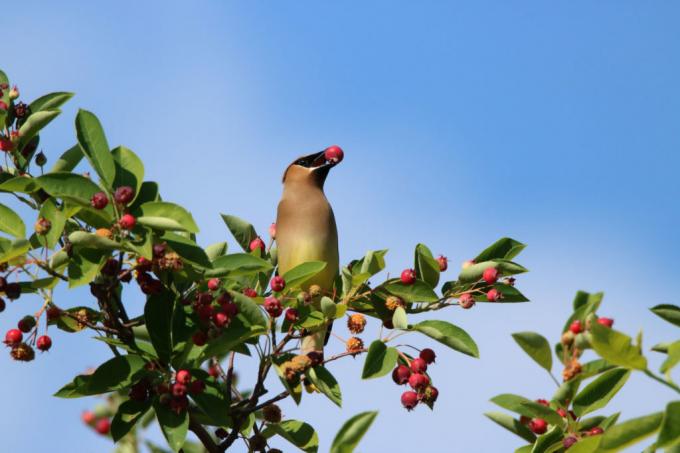
Pear species and varieties
The genus of service pear includes 33 species worldwide. In addition, there are countless varieties of each species. The most interesting species for growing in the garden are presented below. We also give tips on the varieties for the respective species.
pear pear (Amelanchier ovalis)
This species is one of two species native to Europe and can be found at altitudes of up to 2000 meters. It doesn't get taller than three meters and doesn't grow as luxuriantly as its relatives from North America. That's why you rarely see them here. Nevertheless, this species also flowers beautifully in spring and is a drought-resistant, attractive flowering shrub. It produces numerous white flowers in May, arranged in threes to sixes in squat, upright racemes. the Fruits are edible. The best-known variety of this type is 'Helvetica': This variety forms narrow, compact shrubs that are one to three meters high, which are also well suited for growing in pots.
Copper Rock Pear (Amelanchier lamarckii)
The botanical name of the rock pear goes back to the French botanist Jean-Baptiste de Lamarck, who first described this species in 1783. It originally comes from eastern North America. It is not known how and when this pear species came to Europe. Since the climate here was so good for her, she spread very quickly and became wild. in the 19th century Amelanchier lamarckii Cultivated in Germany as a fruit tree and valued ever since - and it is still one of our most popular service pear species today. It can grow up to ten meters high and loves a sunny to partially shaded location. The leaves are tinted bronze, turning conspicuous orange to crimson in autumn. From April to May, this species bears white flowers that are heavily frequented by insects. In July and August, it then shows crimson to blue-black, tasty fruits, which not only taste good to us, but also serve as food for many birds such as tits or thrushes.
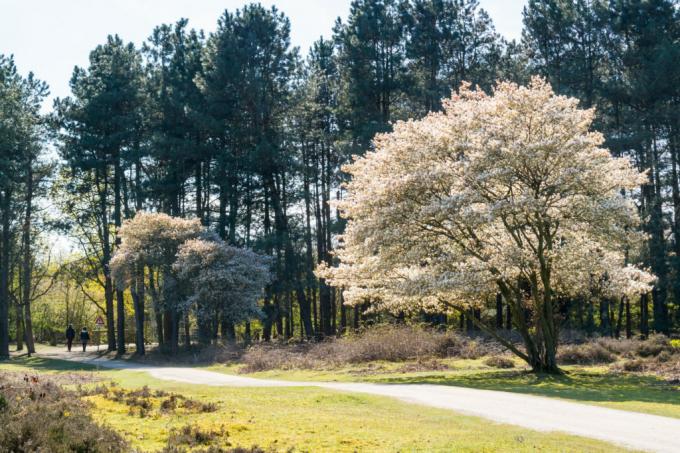
alder pear (Amelanchier alnifolia)
Native to North America, this species is used as both an ornamental and fruiting shrub. In Canada there are even orchards with this species of pear and Canadian Indians have been collecting their fruit for 3000 years. Grows as a wild shrub Amelanchier alnifolia preferably on river banks, in forests or in the steppe. This species includes the greatest diversity of varieties among the service pears:
- ‘Fastagiata’: Columnar and multi-stemmed, this variety grows up to four meters tall.
- ‘Forstburg’: This very productive variety bears large and thick fruits that taste sweet and delicious.
- ‘Greatberry Garden': This variety is valued above all for its tasty fruits.
- ‘northline': This variety grows up to four meters high and flowers particularly early.
- ‘obelisk': This variety convinces with a slender, upright growth and can grow up to three meters high. It can also be planted as a column.
- ‘Saskatoon Berry': This variety is particularly well suited as a solitary tree, because it convinces with an upright habit and a growth height of up to four meters.
- 'Smokey': The shrubs of this variety grow up to 4.4 meters tall and bear tasty fruit.
bare pear (Amelanchier laevis)
The bald pear forms particularly large shrubs that can reach heights of between 8 and 13 meters. But she is not bald, as the name might suggest. The leaves also change color beautifully in autumn. Some recommended varieties of this species are:
- ‘ballerina': One of the most popular varieties of the service pear. It grows as a tall, upright shrub and produces numerous, tasty fruits.
- 'edelweiss': The shrubs of this variety can grow up to five meters tall. They also impress with a magnificent bloom in the spring.
- 'Snowflakes': This variety forms large shrubs. It bears large, juicy fruits that can be up to two centimeters thick.

Tree Rock Pear (Amelanchier arborea)
As the name suggests, service pear trees of this type grow particularly high into large shrubs or small trees. Some specimens of this species can even grow up to 20 meters high. The most famous variety Amelanchier arborea is 'Robin Hill': This variety can grow up to six meters high and is particularly suitable for tall trees.
Canadian pear
The Canadian Serviceberry (Amelanchier canadensis) is native to eastern North America. It is characterized by its large growth height of up to eight meters and is largely limited to wet locations. the Fruits are also edible. Some Interesting Varieties of Amelanchier canadensis are the following:
- 'October Flame': This variety owes its name to the fiery red color of the leaves in autumn.
- 'Prince William': The numerous, beautiful flowers and particularly large fruits characterize this variety.
- 'Rainbow Pillar': This variety grows in a columnar manner and also yields edible, sweetish fruits.
Buy pear pear
At the Purchase of pears the choice of variety is particularly important, because the variety determines the size, growth habit and fruit yield of your future pear fruit. Other important criteria when buying are these:
- Vital, healthy impression
- Plant free of disease or pests
- size and age of the plant
- Upright growth
You can buy service pears in tree nurseries, garden centers and hardware stores in your area or, if you can't find what you are looking for there, you can order them online.
More about the Purchase of the rock pear Find out in our special article here.
plant service pear
In which location the pear feels particularly comfortable, what to look out for when planting, how you How to do this and how you can also plant your service pear as a standard tree is explained below Section.
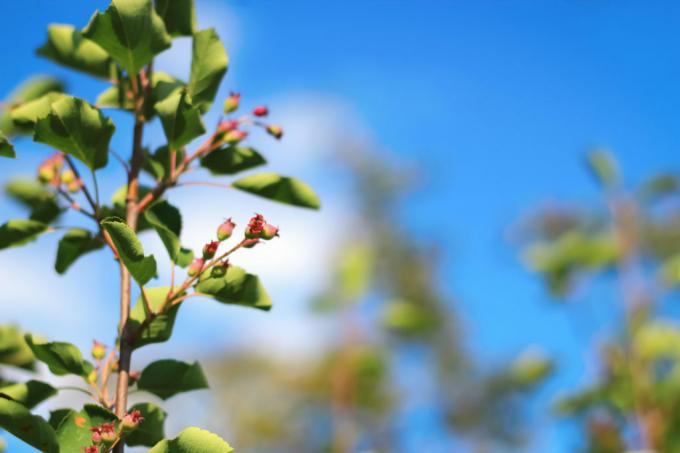
The right location for the service pear
The pear is undemanding when it comes to its location in the garden and can thrive almost anywhere. If it is in a sunny to partially shaded place, it will thank you. Soil should be moderately dry to moist. Too light, sandy soil can be planted with a high-quality potting soil like ours Plantura organic universal soil be improved. The pear is also tolerant when it comes to the pH value: an acidic to slightly alkaline value is not a problem for it. The shrub does well in uncut, wild hedges, but can also be planted as a specimen plant or standard tree.
Summary: Which location does the pear like?
- Undemanding
- Sunny to semi-shady
- Well-drained, moderately dry to moist soil
- pH: 5 - 7.5
Tip: You can even cultivate your service pear in a tub if you have a small species, such as Amelanchier spicata, select and place them in a sufficiently large planter. It is best to use a high-quality soil such as our peat-free soil for planting Plantura organic universal soil and mix them with 1/3 sand. Make sure that the water can drain out of the bottom of the pot, otherwise your pear will soon suffer from root rot.
This is how you proceed when planting the service pear
The best planting time for the service pear is in spring, as soon as frost is no longer to be expected, or in autumn.
Soak the shrub's root ball for about an hour by placing it in a bucket of lukewarm water. During this time you can prepare the soil by loosening it deeply and removing any larger stones. Then enrich the soil with compost or a long-acting organic fertilizer. Our Plantura organic universal fertilizer creates the best conditions for your service pear to grow.
Next, the planting hole is dug. This should be at least twice the size of the root ball. The bush is placed in the center of this hole. Make sure that the root ball is only planted as deep as it was in the pot. Then you can fill the hole with the excavation and cast it.

Planting service pear: step-by-step instructions
- Deeply loosen the soil
- Work compost or a slow release organic fertilizer into the soil
- water the root ball
- dig planting hole; at least twice the circumference of the root ball
- Put in the middle of the hole
- Plant only as deep as the plant was in the container
- Fill the hole with excavation
- casting
To plant your service pear in a bucket, first select a sufficiently large planter. Then create a drainage layer in the pot, for example made of expanded clay or pottery shards, so that the irrigation water in the pot can drain off easily. Then mix the substrate with our Plantura Organic universal fertilizer with an organic long-term effect to ensure the ideal nutrient supply for your service pear from the start. Then fill the container one third with the substrate, place the plant in the middle of the container and fill it up with the substrate. Then the rock pear is only poured on. Now nothing stands in the way of your growth.
Summary: How do you plant service pear trees in a pot?
- Select a sufficiently large planter
- create a drainage layer
- substrate with Plantura organic universal fertilizer Mix
- Fill the vessel one-third full with substrate
- Place the pear in the middle of the pot
- Fill the pot with substrate
- casting
Plant service pear as a standard
Whether as an ornamental shrub or fruit tree - you can also plant your service pear as a standard tree. Particular attention should be paid to the planting distance, otherwise the shrub can be overshadowed by other trees or shrubs and not develop so well. Therefore, plant it at a distance of eight to ten meters from other trees or place it alone in the meadow as a solitary plant. To make it easier for the shrub to grow, you can cut back the above-ground shoots by a third before planting. Then proceed with planting as described above. It is important for the high stem that you pay attention to the right nutrient supply right from the start. Therefore, before planting, work ours Plantura organic universal fertilizer into the soil with an organic long-term effect. In this way you offer your future standard the best conditions to be able to grow well. After the young shrub is planted, you should dig a stake deep enough into the ground in the immediate vicinity for support. The pear is then tied to the stick with a piece of string - this gives it enough support.
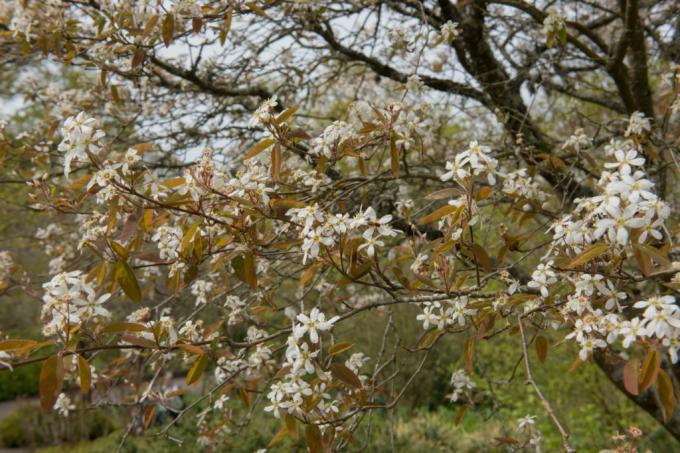
What should be considered when planting the service pear as a standard?
- Planting distance to other trees: 8 - 10 meters
- Or plant as a specimen tree
- Cut back shoots above ground by a third
- Proceed as described above when planting
- Basic fertilization with Plantura Organic universal fertilizer [do not forget
- Tie the plant to a stick for support
Cultivate service pear
Once the pear has been planted, you don't need to do much and you can enjoy the shrub. In the next section you will find out what to look out for when fertilizing, watering and cutting the service pear
Pour and fertilize the pear
Rock pear trees are super easy to care for and actually get along well with nutrient-poor and dry conditions. Therefore, the motto when caring for service pear trees should always be: Less is more. You don't actually have to water your pear tree at all. The service pear should only be kept sufficiently moist after planting; this also applies to young service pears. In the case of long periods of drought, you must of course save your service pear from drying out. You should also not be too generous with the fertilizer. One fertilization per year is sufficient. To do this, you can work compost or a long-term organic fertilizer into the soil in spring. Our Plantura Organic universal fertilizer releases the valuable nutrients slowly and gently to the plant. In this way, the service pear is supplied with nutrients in the long term and there is no risk of over-fertilization.
Summary: Fertilize and water like the service pear
- Less is more
- Water only when young and during long periods of drought
- One-time fertilizer application in spring
Cut rock pear
You may already have guessed that the pear is easy to care for when pruning. Your beautifully shaped crown forms all by itself, you don't have to help with the pruning shears.
Under no circumstances should you radically cut back older shrubs, as new shoots will only grow back very slowly afterwards.
If a pear grows too densely for you, you can cut off individual shoots just above the ground in winter to thin out the crown. You can then remove dead shoots at the same time
How do you cut rock pears?
- Crown forms by itself
- Regular pruning or pruning is therefore not necessary
- Never prune older plants radically
- Thin out too dense growth in winter
- Cut off shoots close to the ground
- Remove dead shoots
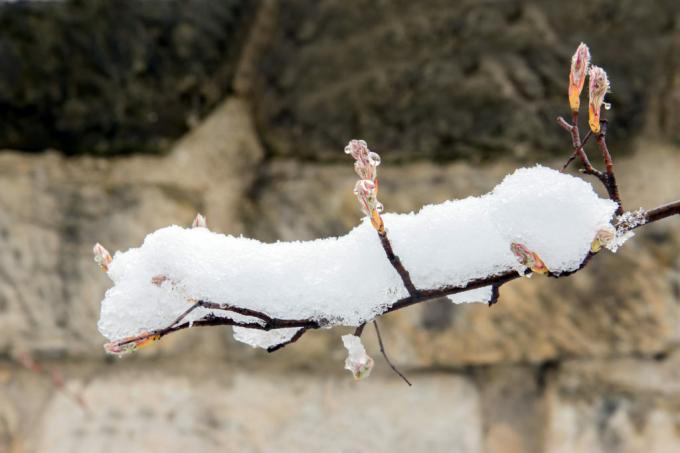
multiply service pear
Rock pear can by sowing, cuttings or grafting to be propagated.
Propagation by seed works particularly well with wild species. For this it is important that the seeds have been exposed to a cold period, otherwise they will not be able to germinate.
Cuttings can be cut in spring, preferably in April or May. Choose a fresh shoot, which should already be 5 to 15 centimeters long at the time. All leaves are removed from this and then placed in a special cuttings substrate. However, the propagation of cuttings in service pear is difficult and rarely crowned with success.
Rowanberry seedlings can be used as a base for grafting.
Overwinter service pear
The service pear is hardy and absolutely frost tolerant. Even particularly icy winters cannot harm the shrub. All types of service pear can easily overwinter in your garden and do not require any special protection.
Harvesting and storing Rock Pear fruit
In the summer between June and August the catch Fruits of the pear starting to mature. But be patient and don't harvest the vitamin bombs too early, because they don't ripen and don't taste good when they're unripe. You can tell whether the fruit is really ripe for harvest by the colour: depending on the degree of ripeness they get darker and darker and can - depending on the variety - be harvested when they are dark blue to black are. The fruits of the pear ripen gradually on the bush, which means that not all fruits are ready for harvest at the same time. Therefore, you can pick ripe fruit from the bush again and again over a longer period of time.
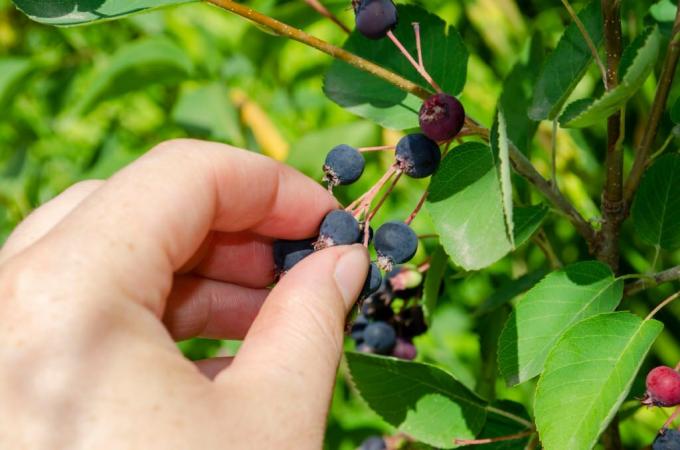
Tip: Rock pears are not only popular with people, but also with birds. So if you want to enjoy the fruits, you have to be quicker than crows and the like with the harvest or protect the bush from robbers with a net in summer.
Unfortunately, fresh pears can only be kept for a few days in the refrigerator. But there are many ways to preserve the healthy fruit. Along with other berries like raspberries (Rubus idaeus) or currants (Ribes) the pears can be boiled down to make jam, jelly, juice or compote. If you like it alcoholic, you can also make a homemade liqueur or wine from the fruit. Dried rock pears can also be used as a tea.
Overview: Harvesting and storing Serviceberry fruits
- Harvest time: June – August
- Don't harvest too early
- Darker coloring indicates ripeness for harvest
- Reap again and again
- Fresh only a few days in the refrigerator
- Various processing options: jam, compote, liqueur, tea



